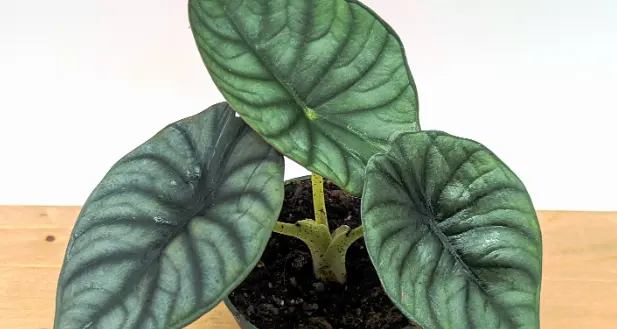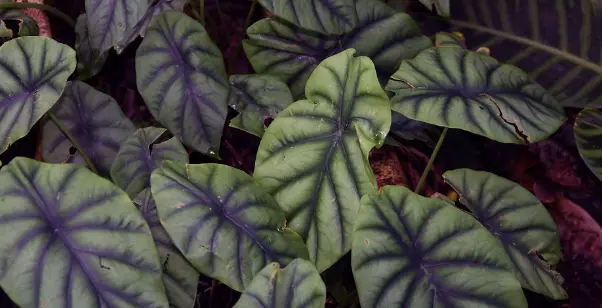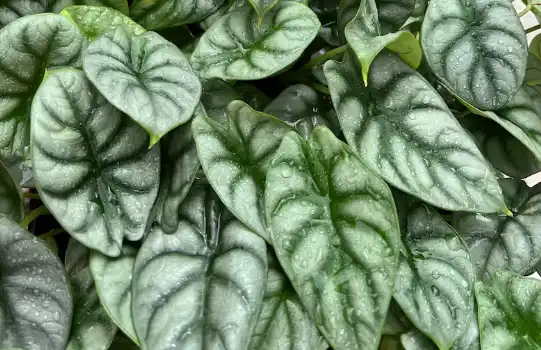Alocasia Nebula care, propagation, leaves problems [All you need to know]
Do you know the detailed guide to care for the alocasia nebula, a rare species of the alocasia genus?
This plant is mostly found in tropical regions. The commercial cultivation of nebula plants is not so enriched and that’s why it has a huge demand all over the world.
In this article, you can get an idea about their appearance, caring measures, confusing plants near to them and some problems of the alocasia nebula plant.
So, Scroll down and search for the information that you need to know about this adorable plant.

Overview
| Scientific name | Alocasia nebula |
| Family | Araceae |
| Origin | Sarawak state, Malaysia |
| Plant height | 20-30 cm |
| Plant type | Lowland tropical plant |
| Leaf | Pale green leaves with a reddish tint on the margin and deep large purple dots on the green surface |
| Stem | 2.5 cm long |
| Sunlight | Bright indirect light |
| Watering | Once a week |
| Humidity | 50-60% |
| Temperature | 48°F to 88°F |
Where to Buy Alocasia Nebula?
As alocasia nebula is a rare plant, you won’t find it everywhere. You may search in the local nurseries around your region. Otherwise, you may purchase it from online plant shops or websites. For your convenience, I am mentioning some websites.
Alocasia Nebula Plant Care Guide
As alocasia nebula are found infrequently, you should take appropriate care of your plant so that it doesn’t lose its aristocratic appearance. Check the caring guides from below for their maintenance.
Alocasia Nebula Light Requirement
Firstly, you should be conscious of the light intensity. It loves bright indirect light to retain its beautiful foliage colors. Be alert so that scorching light may not burn their leaves.
To avoid leaf burning, try to provide a moderate amount of shading so that it can easily adjust with different shades of light.
How To Water Alocasia Nebula Plant?
Next, you have to strictly maintain the watering quality, time and amount as alocasia plants are sensitive to watering. To facilitate their perfect growth, water once a week. If the weather is too scorching and the soil gets dry, then water your plant as it needs.
Best Soil Type For Alocasia Nebula
Soil is the holding matter of a plant. So you must ensure the quality of the soil mixture. Nebula plants like sandy loam, fertilizer-enriched and well-drained soil so that water cannot stand there and nutrients and moisture can be retained in the soil.
Temperature And Humidity Requirement For Alocasia Nebula
If you want to get vigorous growth of your plant, you must ensure appropriate temperature and humidity conditions for them. The temperature range for nebula plants is 48°F to 88°F. Besides, it loves to exist in 50-60% humidity. As it is best suited to the humid climate, you may sprinkle water on its foliage.
Which Is The Best Fertilizer For Alocasia Nebula Plant?
Finally, the caring guide ends with its fertilizer requirement. Nebula plants don’t need excessive fertilization as they are hard enough to maintain themselves. But still, you may use dilute fertilizer (…) which will slowly release to the root. Make sure the perfect ratio of nitrogen, phosphorus and potassium.
Alocasia Nebula Plant Propagation
As alocasia nebula is an uncommon plant, the better way to increase its number is by propagation. Let’s have a glance at the whole procedure of propagation.
- Select a healthy mother plant
Firstly, select a healthy, disease-free and matured plant so that the new seedling may be vibrant. Uproot the plant consciously from the soil and remove the soil slowly.

- Divide the rhizome with scissors
Cut one-third portions of the rhizome with a knife. After separating, keep it in a polythene sheet to avoid disease susceptibility.

- Plant in the pot
Prepare a new pot with sandy loam soil, perlite and coco-peat. Plant the cutting in the pot and water it.

How To Repot Alocasia Nebula Plant?
Repotting is necessary for alocasia nebula plants to overcome root rot, root bound and over watering problems.
For repotting the plant,
- Uproot the plant consciously so that the root system is not disturbed.
- Place the plant in the prepared pot with nutrient-enriched soil mixture.
Why Are My Alocasia Nebula Leaves Turning Brown?
Are you observing brown leaves in your nebula plant? The leaf edges may be attacked first or you may notice brown spots on the leaves. All are due to overwatering, root rot and virus attack which destroys the plants’ food system.

Why Are My Alocasia Nebula Leaves Curling?
Another problem of alocasia nebula plants is leaf curling that occurs due to pest attack. When insects like mealybug or aphids attack the leaves, they suck the cell sap and so the leaves become shrunken and curly.

Why Are My Alocasia Nebula Dying?
Nebula plants exhibit different kinds of symptoms when they go through stressful conditions. If you don’t sort out the problems like imbalanced watering, temperature stress, moisture stress, pest and disease attack and lack of sunlight, your plant may even die.
Alocasia Nebula vs Alocasia Clypeolata Plant
Alocasia nebula plant can be compared to alocasia clypeolata plant due to their venation in the leaves. Though the leaf color is moderate green in clypeolata and pale green in a nebula, the purple veins can resemble one another.

Alocasia Nebula vs Alocasia Silver Dragon Plant
Again, you can compare the nebula plant with the alocasia silver dragon. This time, you will get similarity in their leaf color which is pale green. But there is a difference in the venation. The silver dragon veins are dark green and the nebula veins are purple.

Is Alocasia Nebula Rare?
Alocasia nebula is a rare plant. This hybrid variety cannot be grown in tropical forests and that’s why it is tough to find.
Is Pruning Important For Alocasia Nebula?
Pruning is essential for the alocasia nebula plant. You can remove the old yellow leaves to facilitate their new growth. This, new leaves will come out from the stem.
Final Thoughts
In the end, I would like to say that such a mysterious and pretty ornamental plant like the alocasia nebula is critical to manage. In this condition, if you want to keep this plant, you must have to know the ins and outs of them.
Again, to protect them, you have to know about propagation procedures and maintenance techniques. So enjoy the facts about this beautiful plant from the above-mentioned points and get your nebula right now following the websites.






